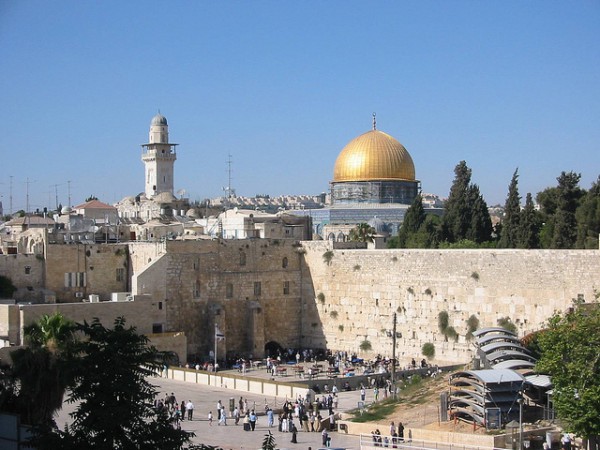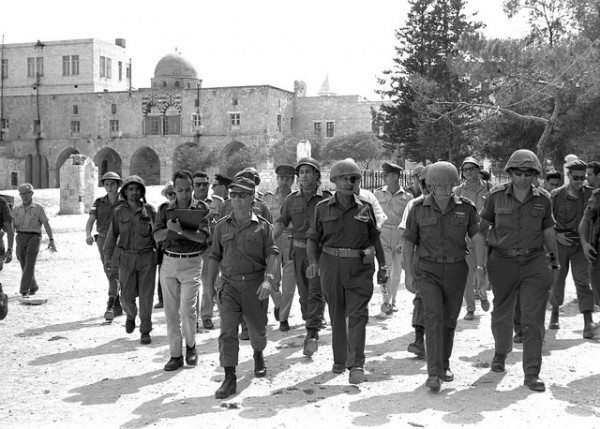“I will raise up Cyrus in my righteousness: I will make all his ways straight. He will rebuild my city and set my exiles free, but not for a price or reward, says the LORD Almighty.” (Isaiah 45:13)
With all of his real estate prowess and deal-making success, will President Donald Trump do as King Cyrus decreed 1,500 years ago and get into the hottest business in the world, Temple building?
Just the idea that a Temple could possibly some day be rebuilt on the Temple Mount causes Palestinians to riot and loot, bomb cars and buildings, stab and shoot innocent civilians.

The Western (Wailing) Wall plaza in Jerusalem: the Dome of the Rock sits on the Temple Mount where the First and Second Temples once stood. At the foot of the Temple Mount, on the western side, is the Western Wall, all that’s left of the ancient wall that once surrounded the Jewish Temple courtyard.
So far, President Trump has been cautious on all building in the contested territories of Judea-Samaria, telling Israeli Prime Minister Netanyahu at their first White House press conference, “I’d like to see you hold back on settlements for a little bit.”
Though Trump would like to see the US Embassy move from Tel Aviv to Jerusalem, he has not made any public statement about building on the Temple Mount.
Nevertheless, the unofficial Sanhedrin council sent a letter to President Trump and President Putin of Russia asking for their help in building the Temple. In 2012, Putin visited the Western Wall and read a psalm from a Hebrew/ Russian prayer book after several minutes of silence. (Arutz Sheva)
Even if these two powerful leaders wanted to do so, however, the worldwide pressure and violence that opposes the very thought of it makes even their plans seem impossible.
Yet, we know it must happen someday.

The Foundation Stone, or Rock (Sakhrah), which is the rock beneath the Dome of the Rock in Jerusalem.
The Saga Begins
One of the greatest tragedies of Israel’s history was the loss of the Holy Temples in Jerusalem. When the Second Temple was destroyed in AD 70, the focal point of Israel’s spiritual life disappeared along with it.
In its place, the Dome of the Rock was erected between 689 and 691, after Muslims captured Jerusalem from the Christian Byzantines in the 7th century.
It was deliberately built on the place where the First and Second Temples once stood to protect the sacred rock, although many Muslim leaders and professors around the world now insist that the Holy Temples never existed.
Al-Quds University Islamic law lecturer Husam Al-Faqih said on Palestinian TV:
“It has been proven historically, and also proven by archaeological excavations conducted by Jewish and non-Jewish archaeologists, that there are no archeological findings that are connected to the Jews. All of the excavations that were conducted at the bottom of the blessed Al-Aqsa Mosque and around it have all yielded Islamic antiquities or ancient Roman antiquities, and there is no proof of the Jews’ claim that the Al-Aqsa Mosque is holy to them.” (PalWatch)
In fact, Palestinian construction workers dumped 400 truckloads of earth into the Kidron valley in the 1990s as they illegally excavated Solomon’s Stables to convert it into a mosque, with no archaeological oversight.
The Temple Mount Sifting Project along with thousands of volunteers are recovering Temple period artifacts from that debris.
The First Temple
“When your days are over and you rest with your ancestors, I will raise up your offspring to succeed you, your own flesh and blood, and I will establish his kingdom. He is the one who will build a house for my Name, and I will establish the throne of his kingdom forever.” (2 Samuel 7:12–13)
David, the shepherd boy who fought Goliath and became King, desired to build a permanent dwelling place for God.
But because he had been a man of war and had too much blood on his hands, the task of building the First Temple was given to his son Shlomo (Solomon), whose name in Hebrew means peace.
That first Temple, built by King Solomon around 1000 BC was destroyed
by the Babylonians in 586 BC on Tisha B’av (the ninth day of the Hebrew
month of Av), and the Jews were exiled in Babylon.

Women praying in the Western Wall tunnels, which expose an additional 485 metres of the Wall. This is a spot in the tunnel where Jewish women can be physically the closest to where the Holy of Holies once stood.
As Jeremiah prophesied, the Jewish people returned to Jerusalem from captivity in Babylon (today Iraq) after 70 years.
“This is what the Lord says: ‘When seventy years are completed for Babylon, I will come to you and fulfill my good promise to bring you back to this place.'” (Jeremiah 29:10)
And about 100 years earlier, Isaiah prophesied the name of the Persian King who would enable the Jewish people to return to Jerusalem, specifically to rebuild the Temple.
Isaiah 44:28:
Who says of Cyrus, ‘He is my shepherd
and will accomplish all that I please;
he will say of Jerusalem, “Let it be rebuilt,”
and of the temple, “Let its foundations be laid.”’
The Second Temple
When the Jews returned to Jerusalem from their Babylonian captivity, they re-built the Temple, which was expanded four hundred years later by King Herod and called “The Glorious Temple.”
Today we call it the Second Temple.
But this Temple also did not stand.
In AD 70 (586 years later), on the same terrible calendar day of Tisha B’Av (the ninth day of Av) that the First Temple was destroyed, the Roman army, led by General Titus, annihilated Jerusalem, razed the Second Temple to the ground, and sent the Jewish People into exile.
For the next nineteen centuries, Jews in exile longed to return to the Promised Land and see the Temple standing once again on the Temple Mount.
Devout Jews still pray three times daily:
“May it be Thy will that the Temple be speedily rebuilt in our days.”
After such a long wait, our generation may live to see the Temple standing in Jerusalem.

The Holy of Holies (Kodesh Kodashim) was the most important room in the Temple, and housed the two tablets of the Ten Commandments inside the Ark of the Covenant.
The Holy Mandate
“Then have them make a sanctuary for me, and I will dwell among them.” (Exodus 25:8)
God has never withdrawn His command that Israel build Him a Sanctuary.
In fact, the Prophet Haggai rebuked the people for neglecting the work of rebuilding the Lord’s house.
“Then the word of the Lord came through the prophet Haggai. ‘Is it a time for you yourselves to be living in your paneled houses, while this house remains a ruin?’” (Haggai 1:3–4)
Under the leadership of Zerubbabel, the work of rebuilding the Temple began.
“So the Lord stirred up the spirit of Zerubbabel son of Shealtiel, governor of Judah, and the spirit of Joshua son of Jozadak, the high priest, and the spirit of the whole remnant of the people. They came and began to work on the house of the Lord Almighty, their God.” (Haggai 1:14)
Several organizations have taken up this calling, but one in particular has already made the preparations.
The Third Temple: The Preparations are Ready
Most of the preparations for the building of the Third Temple are already completed by an organization called The Temple Institute, which is located in the Jewish quarter of Jerusalem’s walled Old City.
As part of its mandate, this Orthodox Jewish organization has completed the restoration and construction of many sacred vessels necessary for use in service for the Holy Temple. These are no mere replicas or models, but authentic vessels, made from gold, copper, silver, and wood.
Included among these are gold and silver vessels used in the incense and sacrificial services of the Cohen HaGadol (High Priest) and the Levitical musical instruments.
Also completed after years of painstaking research and development is the sacred garment or ephod of the Cohen HaGadol as well as his choshen (breastplate) and the tziz zahav (golden crown).
Rabbi Yisrael Ariel: Founder of the Temple Institute of Jerusalem
Who was the mastermind behind this ambitious and risky project?
The Orthodox Jewish Rabbi, Yisrael Ariel, founder and former director of the Temple Institute, is a renowned Biblical scholar and author of several Hebrew books, including the Atlas of the Biblical Boundaries of the Land of Israel.
He believes that each and every generation of Jews is obliged to do all they can to rebuild the Holy Temple.
Rabbi Ariel’s convictions run counter to some Orthodox Jews who believe that we must wait patiently for the Messiah (Moshiach) to come before the Temple may be rebuilt. Nevertheless, Rabbi Ariel is zealous about his convictions.
As a soldier in the Israeli Defense Forces’ paratrooper brigade, he was one of the first soldiers to reach the Temple Mount when it was liberated by Israel in the Six Day War of 1967.

In this iconic Six Day War photo, shot just after taking Jerusalem back, three battle-weary paratroopers, Zion Karasenti, Yitzak Yifat, Haim Oshri, seem stunned by the beauty of the walls of Jerusalem.
On June 7, 1967, for the first time in almost 1,900 years, Jerusalem came back under Jewish control, and Rabbi Ariel was there. At that time, he says, the vision was birthed in his heart to do all in his power to assist in the rebuilding of the Holy Temple.
Twenty-one days later, on June 28, 1967, the Knesset passed a decree annexing East Jerusalem, thereby bringing the entire city of Jerusalem back under Jewish control.
Rabbi Ariel writes in his Siddur HaMikdash (Holy Temple Prayerbook).
“It is so very difficult to describe the feeling that filled us during that extraordinary time in the life of the nation. The words ‘ringing the bells of the Messiah’ express in a limited way what was being felt in the heart.
“This led to a certain sense of letdown that so many of us experienced. After all, we have arrived at the threshold of the Holy Temple: we are standing at the Western Wall—where is the Messiah?”
He explains that over time he realized expectations were “misplaced” and
that God expected the Jewish People to be proactive in the rebuilding of the Temple.
“Through the years, the more I studied the more I began to understand that we had only ourselves and our own inaction to hold accountable: God does not intend for us to wait for a day of miracles. We are expected to act.
“We must accomplish that with which we have been charged: to do all in our power to prepare for the rebuilding of the Holy Temple, and the renewal of the divine service (Siddur HaMikdash, page 526).”
Prophetic Significance
Scripture indicates that the Temple will be standing on its original location on the Temple Mount before the return of Yeshua (Jesus).
“Know and understand this: From the time the word goes out to restore and rebuild Jerusalem until the Anointed One, the ruler, comes, there will be seven ‘sevens,’ and sixty-two ‘sevens.’ It will be rebuilt with streets and a trench, but in times of trouble.” (Daniel 9:25)
The fact that the vessels, garments, and even the building plans are already prepared has great prophetic significance for those who await the return of Messiah Yeshua.
Yeshua said that when the fig tree (a symbol for Israel) blossoms, His return
is imminent—He is right at the door.
“Now learn this lesson from the fig tree: As soon as its twigs get tender and its leaves come out, you know that summer is near. Even so, when you see all these things, you know that it is near, right at the door.” (Matthew 24:32–34)
The fact that Israel was reborn as a nation in 1948 is one of the indications that this generation is an end-time generation. So, we must be very cautious as Believers.
Yeshua warned that in the very end days, there will be a Great Tribulation.
“When you see standing in the holy place ‘the abomination that causes desolation,’ spoken of through the prophet Daniel—let the reader understand—then let those who are in Judea flee to the mountains.” (Matthew 24:15-16)
What will this abomination of desolation do?
“His armed forces will rise up to desecrate the temple fortress and will abolish the daily sacrifice. Then they will set up the abomination that causes desolation.” (Daniel 11:31)
It is wise, then, to prepare ourselves and loved ones for such a time, especially in deepening our relationship with the Lord.
Opposition and Challenges to Rebuilding the Temple
Of course, a project of this magnitude doesn’t come without practical, religious, and political challenges and opposition.
The most obvious obstacle to the rebuilding of the Temple is that the 37-acre Temple Mount upon which it needs to be rebuilt is under Muslim control.
You may be asking yourself: If Israel liberated and regained control over all of Jerusalem during the Six Day War in 1967, then why was the holiest site for the Jews, the Temple Mount, given to the Muslims?
The answer to this question is tragic.
After such a hard-won, against-all-odds, spectacular Israeli victory, General Moshe Dayan, then Minister of Defense and a secular Jew (who did not believe that the Bible was the Word of God), met with the five leaders of the Supreme Muslim Religious Council at the Al-Aqsa Mosque.

Six Day War: (left to right) Jerusalem Commander Uzi Narkis, Defense Minister Moshe Dayan, IDF Chief of Staff Yitzhak Rabin, and General Rehavam Ze’evi walk through the Old City of Jerusalem.
At this meeting, General Dayan ordered the removal of the Israeli flag, which IDF soldiers had risked their lives to hang from the golden dome.
Dayan also handed over administrative control to the Arabs (a Jordanian-controlled Muslim trust called the Waqf). This policy—that Arab authorities control and police Israel’s most sacred site—remains unchanged until today.
Although Jews are permitted limited access to the site of the Temple Mount, the reading of Jewish Scriptures or praying by either Jews or Christians is prohibited, despite the fact that access to holy sites is guaranteed under Israeli law.
Because Muslim authorities do not permit Jewish prayer on the Temple Mount, the custom of praying near the Western Wall developed.
The Wall is the nearest to the ancient site of the Holy of Holies.
On Top of this, the chief rabbis have warned Jews not to pray on the Temple Mount because they might desecrate the Holy of Holies, by unknowingly standing on this place where only the High Priest was allowed to enter.
When the Temple stood, access to the site was limited by a complex set of purity laws, and entrance was only permitted for the fulfillment of a religious precept.
Today, with Israel surrounded by a sea of hostile Arab neighbors bent on
her destruction, and with the Dome of the Rock sitting defiantly on the
Temple Mount, rebuilding the Holy Temple may seem like an impossibility.
However, the Bible assures us that a Temple will be rebuilt, if not by God’s doing then by man’s, and if not in our generation then maybe the next.
While we don’t know where on the Temple Mount the Third Temple will be
built or how soon this will take place, we do know that we are approaching the Days of the coming of Messiah.











